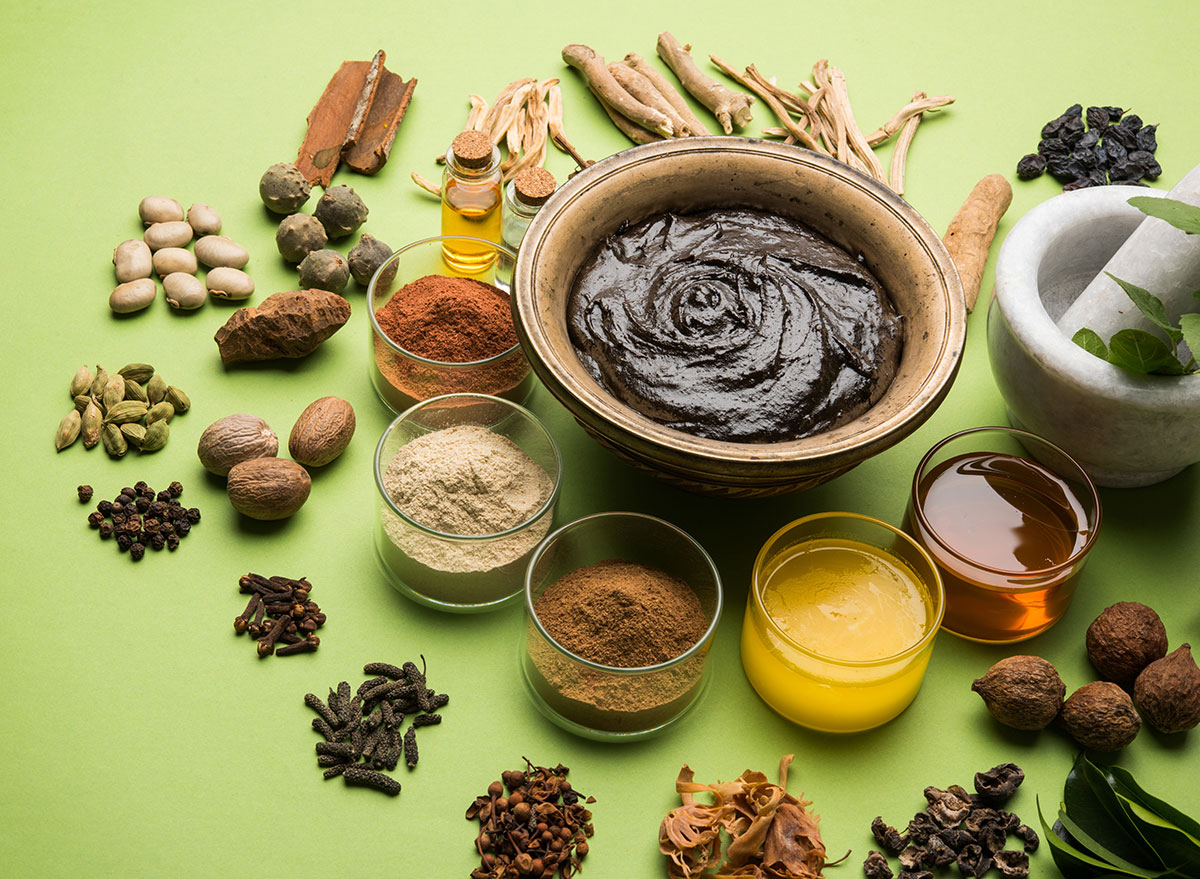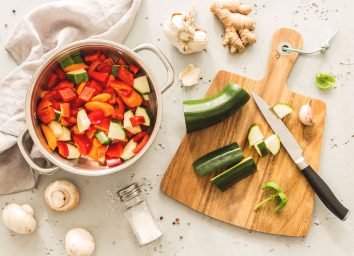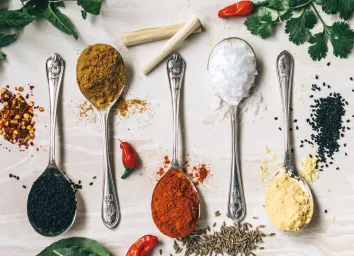What Is an Ayurvedic Diet? Discover Your Dosha & How to Properly Fuel It

In Eastern medicine, specifically that of the ancient Indian practice Ayurveda, it is believed that the state of your physical health is a reflection of your mental health, and vice-versa. According to The Chopra Center, Ayurveda is “a science of life,” and the two main guiding principles of this practice are that “the mind and body are inextricably connected,” and “nothing has more power to heal and transform the body than the mind.” What does that have to do with food, you ask? Everything. Enter the Ayurvedic diet.
Per The Chopra Center, those who live an Ayurvedic lifestyle believe eating is “our most vital bodily function,” (next to breathing, of course). This is because as humans we ingest a lot more than food. Humans are constantly digesting information, emotions, and sensory cues, and it all has an effect on your overall health. However, if you can first nourish your digestive system through not only the foods you eat, but also how you eat them, the physical results you’re looking for (clearer skin, weight loss, strong nails, and shiny hair, to name a few), and mental clarity, on top of an overall sense of health, will follow.
So what is this magical Ayurvedic diet? An Ayurvedic diet is a way of eating that serves you as an individual, and works by pertaining to your doshas, or “biological humors or energetic forces of nature that govern our internal and external environments,” according to Erin Sprague, an Ayurvedic Health Counselor, brand specialist, and member of the OJAS STUDIO Collective. In other words, the Ayurvedic diet is eating with the intention to balance your unique, internal energies to benefit your physical body.
Read on to find out how you can adapt to the Ayurvedic diet and lifestyle, as Sprague offers us an exclusive breakdown of all things Ayurvedic eating, and the three main doshas—what they are, what they mean, and the foods to add to your Ayurvedic grocery list ASAP.
What are the three doshas, and how are they defined?
Each and every one of us is born with a specific “doshic arrangement,” one or two doshas that we resonate with over others, Sprague explains. The three doshas, she says, are “functional principles that help us to understand ourselves and the world around us.”
Vata
Vata is “the dosha of movement and made of ether and air,” Sprague tells us, and those with primarily vata traits will often have a smaller bone structure, she says, and tend to have “light, airy, creative personalities.”
Pitta
“Pitta is the dosha of transformation and composed of fire and water,” Sprague explains. Unlike Vatta, who are more light-hearted and easy going, individuals with a lot of pitta in their nature are more intense in their drive and focus, and are “of medium build,” according to Sprague.
Kapha
Sprague describes Kapha as being the “dosha of structure,” made up of a combination of water and earth elements. To put it simply: If Vatta is airy, Kapha is solid, as individuals with kapha dosha dominant are “strong, stable, and steady in character, physique, and mindset,” she says.
What kinds of foods are best for each dosha?
Foods for Vata
“Vata is made of [sky] and air and is prominent in the fall season, which is dry, rough, hard, and cold,” Sprague says. Someone with predominantly vata energy should gravitate toward foods that are “warm, dense, soft and oily, such as squashes, soups, stews, grains, and warming spices like turmeric, cayenne, cinnamon, etc.,” she explains.
- Eat: Cooked vegetables, basmati rice, brown rice, oats and wheat, soaked nuts, dairy (especially fermented), and oils like sesame, ghee, and almond
- Avoid: Dried fruits, raw apples, melons, cranberries, raw veggies, mushrooms, lettuce, dry grains, and animal products
Foods for Pitta
Because pitta is made of fire and water and rules the summer season, which is hot, sharp, oily, and light, Sprague says eating “cooling, fresh, raw foods like cucumbers, apples, coconut, melons, and spices like coriander or fennel,” will balance them out.
- Eat: Sweet and astringent fruits such as apples, cranberries, and dates, vegetables, basmati rice, oats, wheat, corn and granola, coconut bits, coconut water, sweet dairy, and oil in moderation
- Avoid: Sour fruits, chiles, garlic, onions, pickles, cultured dairy, and animal products
Foods for Kapha
“Kapha is composed of water and earth, and its season is late winter to spring,” Sprague explains. “To balance the cold, wet, sticky, heavy nature of Kapha, one should eat light, warm, drying foods, such as bitter greens, radishes, onions, chickpeas, ginger, turmeric, and chiles.”
- Eat: Dried fruit, apples, cranberries, raisins and prunes, astringent and pungent vegetables like alfalfa sprouts, asparagus and bell peppers, barley, buckwheat, corn, and rye, pumpkin seeds, sunflower seeds, non-dairy milks, and sunflower and olive oil
- Avoid: Sweet fruits, okra, sweet potatoes, oats, wheat, dairy, and most animal products
What are the benefits of following an Ayurvedic diet?
It’s flexible.
Whether you’ve committed to keto, your best friend’s playing around with paleo, your sister’s dabbling in vegetarianism, or your mom’s munching Mediterranean style, we all share one common goal: To find a way of eating that works for our bodies and makes us feel good. Unfortunately, diet culture makes achieving this more difficult than it has to be by assigning restrictions and encouraging deprivation, which doesn’t necessarily help every single person thrive in the long term.
Unlike other mainstream diets that are usually restrictive and come with all sorts of parameters, the Ayurvedic diet is less about calorie counting and depriving yourself of indulgences. Instead, it’s about promoting the consumption of delicious, wholesome, nutritious foods that nurture who you are, and offer what your body needs in that moment. Translation: The Ayurvedic diet is constantly changing because you are always changing.
“[When following an Ayurvedic diet] one works to develop an individualized dietary and lifestyle plan that brings balance to whichever dosha or combination of doshas is most prominent at that moment—either seasonally or internally,” Sprague explains. Because of this, she adds, how you eat “has the fluidity to change as circumstances and seasons shift.”
It’s personal.
Unless you’re actively working with a registered dietitian or nutritionist while following a popular diet like the keto diet or paleo diet, it’s likely that you’re following a plan drawn up by a stranger who isn’t familiar with your individual body—what it’s feeling, what it likes, dislikes, thrives on, etc. The Ayurvedic diet, however, is a personal plan that caters to your unique dosha; you thrive and see the results you desire by catering to you.
There’s a saying that goes “another man’s trash is another person’s treasure.” Well, what might be harmful for your dietary needs could very well end up being very beneficial for, say, your best friend, or a loved one—or vice-versa.
“[The Ayurvedic diet] works to bring you as a unique person into a better state of physical, emotional, and mental balance,” Sprague says. “Whatever dosha is out of balance at the moment needs foods with the opposite qualities to help bring you toward homeostasis.” Therefore, when your dosha shifts, so should your food choices return to a state of balance.
It promotes optimal digestion and overall health.
Sague explains that there are two components to adhering to the Ayurvedic diet. The first is eating in a way that balances your dosha energies. The second is implementing little habits, such as not drinking too many cold beverages and making lunch the largest meal of your day, to promote not only optimal digestion, but optimal health overall.
“The benefits of eating this way are endless—better sleep, clarity of mind, clearer skin, weight loss, reduced inflammation, increased energy, etc.,” Sprague says, which, collectively, add up to an optimal state of overall health, both mentally and physically. “When you are eating in a way that is individually designed, you are working to eradicate all of your specific physiological struggles or ailments.” The physical benefits will follow, she adds.
It enhances your mental clarity.
When your digestive system isn’t working optimally, neither is the rest of your body, and that includes your mind. As soon as you begin to eat in a way that balances your doshas and complies with basic Ayurvedic principles, Sprague says your digestion will improve, and, in turn, any mental fog or lethargy you’re experiencing will dissolve.
It promotes a stronger mind-body connection.
The Ayurvedic diet encourages you to be mindful with your food in every sense of the word. To eat according to your body requires you to both listen and honor whatever is going on internally. This means becoming comfortable with your hunger cues, learning how to identify what your body is craving/needs more of, and being present in the moment you sit down for a meal.
“Meals are meant to be eaten in a slow and relaxed manner, with full attention given to the food,” Sague says, adding that eating in silence is also encouraged, in addition to rituals like eating by candlelight or giving thanks.
How can you identify your dosha?
So now that you know what doshas are, the significance of doshas to your diet and health, and how to shop for each dosha, naturally, the next step is to figure out what your dosha is. According to Sprague, there are a few ways you can go about doing this: You can either meet with an Ayurvedic health counselor or consultant, or, if you’d initially prefer going the inexpensive and easily digestible route, you can start by taking an online quiz from OJAS Studio, which is a food and lifestyle brand on a mission to help people adopt Ayurvedic practices through their snacks, each of which are designed to help balance a specific dosha and promote a sense of vitality in the body. Now, it’s time to get your dosha on!








